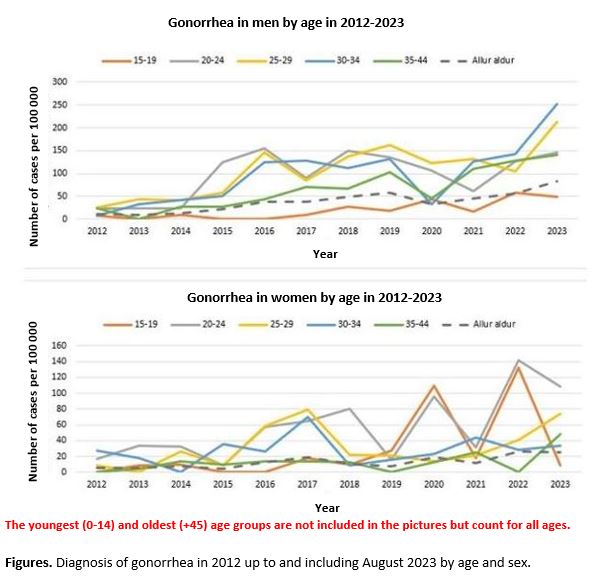Increase in gonorrhea in Iceland
7th September 2023
Gonorrhoea is a sexually transmitted disease caused by Neisseria gonorrhoeae bacteria. Gonorrhoea is most often acquired through direct mucosal contact during sex, and the bacteria can colonize the genitals, urinary tract, rectum, and throat. From there, the bacteria can enter the eye with infected lymph nodes and cause eye infections in newborns at birth. Infection of the rectum and throat is usually asymptomatic. If symptoms appear, they are usually 1–7 days after infection, but symptoms can develop later.
-Automatic translation
In men, the most common symptom is burning or discomfort when urinating (urinary tract inflammation) with pus-like discharge from the urethra. Asymptomatic infection in men is less common than in women.
Symptoms of female genitourinary tract infections are often altered or increased discharge and abdominal pain in the lower abdomen. Other symptoms include breakthrough bleeding or burning and discomfort when urinating. Women are often asymptomatic or asymptomatic.
Increase in cases in 2022 and 2023
An increase in cases in 2022 and 2023 has been in Iceland in the form of diagnosis of the sexually transmitted infection gonorrhoea. In 2022, 158 individuals were diagnosed, the highest number of whom had been diagnosed in 30 years, but after 1990 the incidence of the disease had declined sharply. The number of gonorrhoea cases continues to rise and with the month of


August 2023, 213 gonorrhoea cases have been diagnosed. Thus, the number of diagnoses has become much higher in the first eight months of the year than in the whole of the previous year.
When cases are compared with the same period in 2022, the first eight months of 2023 show that the greatest proportional increase occurred in the 25–34 age groups for men and 25–29 years for women. However, no woman was diagnosed with gonorrhoea in 2022 in the age group 35–44 years, but the first eight months of 2023 have identified 12 women in this age group, which is more than the number diagnosed in previous years. The incidence of gonorrhoea is generally lower in women than men and therefore the amplitude of this decrease is larger between years. It should be kept in mind that not many cases are needed for the relative increase between years to be large.
Why is this increase now?
No specific explanation has been given for what is causing this dramatic increase in gonorrhoea now. The use of condoms during sex significantly reduces the transmission of sexually transmitted diseases, and there is debate about whether condom use has been reduced in general. No recent studies or data are available on this matter in Iceland but in some neighbouring countries behavioural studies, including the use of condoms, have been started. An alternative explanation may be that asymptomatic or asymptomatic individuals are unaware of the infection and unknowingly infect other people, especially if a condom is not used. Women are often asymptomatic or asymptomatic, as does an infection of the anus and throat, which often goes without symptoms in both sexes. Therefore it is essential that sexually transmitted infections are always infection-transmitted, samples taken from persons who have sex for a second time (in the period of 12 months) and that infected persons receive and complete treatment.
The same trend of increase in cases has been observed in the other Nordic countries as in most parts of continental Europe. In some countries, the younger age groups have experienced the most increases, which is of particular concern because gonorrhoea can cause severe abdominal infections and lead to infertility. In addition, a child can become infected at birth and develop a serious eye infection. There is also growing concern about antibiotic-resistant gonorrhoea bacteria, which are then resistant to the drugs that are normally used. Antibiotic-resistant gonorrhoea bacteria have been detected in some other countries and there is cause for concern about their spread. Increased antibiotic resistance means that gonorrhoea is harder to treat with antibiotics and thus harder to recover and limit the spread of the disease.
What can you do?
The use of condoms during sex is effective against sexually transmitted diseases and significantly reduces the transmission of gonorrhoea bacteria.
The Chief Epidemiologist encourages individuals who have suspected gonorrhoea, whether symptoms are present or not, to undergo sampling. Treatment for gonorrhoea is available and it is important to end it and not have sex during treatment. Sampling can be done free of charge at the outpatient clinic for skin and sexually transmitted diseases and at health clinics.
Read more: Information about gonorrhoea and other transmitted diseases
The Chief Epidemiologist
Sources:
